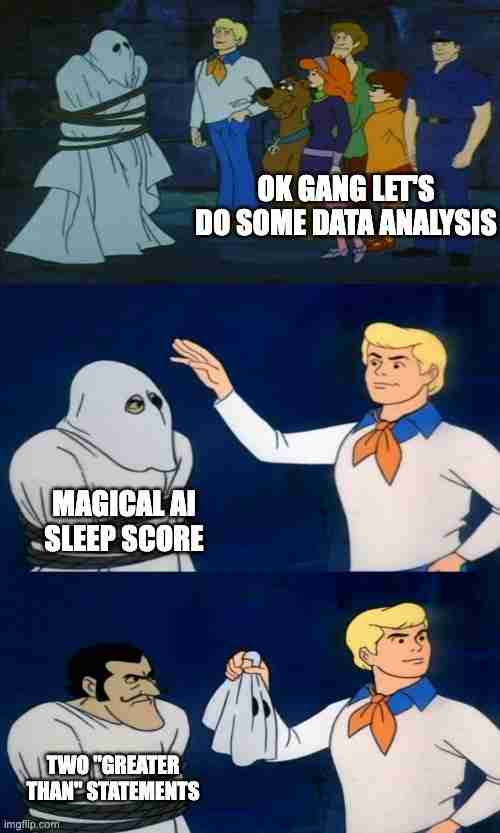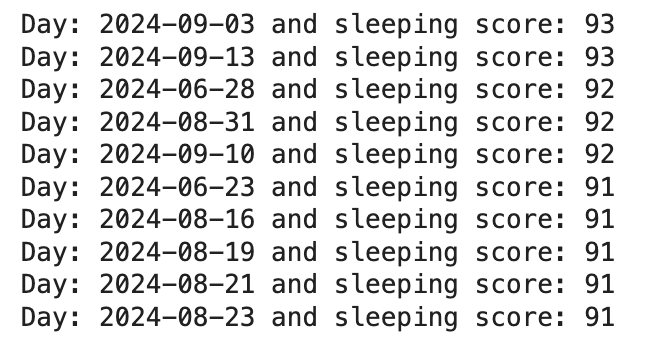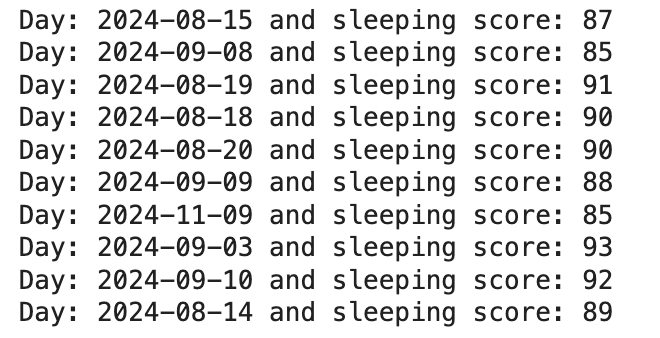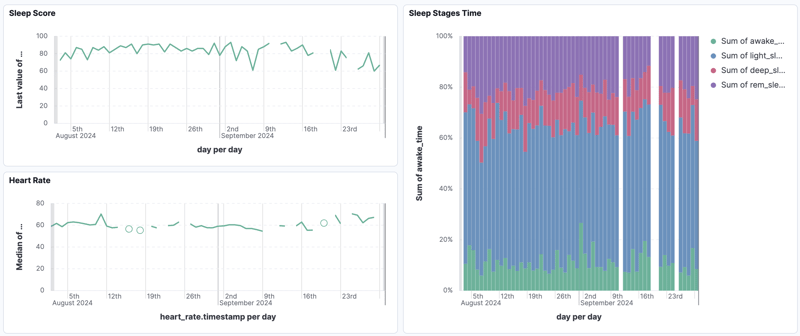Analyzing my Oura sleep score - is it AI or just math?
Today, I delved into my Oura ring's sleep score data, prompting a crucial question: Does this problem require AI, or will a simple formula suffice?

Activity Tracking and the Oura Ring
I'm a data-driven health enthusiast, utilizing fitness trackers like Fitbit and Garmin. However, for everyday wear, I prefer the Oura ring for its discreet design. Sleep tracking is a key feature, making its sleep score worthy of investigation. (For those unfamiliar, Oura's sleep score is detailed on their blog.)
The Enigmatic Sleep Score
A drawback of Oura is its paywalled insights. The free version only displays the sleep score, unlike Fitbit and Garmin's comprehensive dashboards. This raises the question: What makes this sleep score so special, and is the subscription worth it?
The Hypothesis: Simple Correlations
My initial hypothesis, as a data scientist, was straightforward: Higher deep sleep duration and lower average heart rate correlate with better sleep scores. Could it be that simple? Let's find out.
Data Acquisition and Processing
I accessed my Oura data via their developer API, retrieving sleep data and saving it as a JSON file.
def get_data(type):
url = 'https://api.ouraring.com/v2/usercollection/' + type
params={
'start_date': '2021-11-01',
'end_date': '2025-01-01'
}
headers = {
'Authorization': 'Bearer ' + auth_token
}
response = requests.request('GET', url, headers=headers, params=params)
return response.json()["data"]
data = get_data("sleep")
with open('oura_data_sleep.json', 'w', encoding='utf-8') as f:
json.dump(data, f, ensure_ascii=False, indent=4)This data was then indexed in Elasticsearch for easy querying. The JSON structure simplified this process, requiring no extra mapping or data cleaning.
client = Elasticsearch(
cloud_id=ELASTIC_CLOUD_ID,
api_key=ELASTIC_API_KEY
)
index_name = 'oura-history-sleep'
# ... (Elasticsearch index creation and data loading code) ...The Experiment: Simple Queries
My experiment involved simple queries to test my hypothesis. I first sorted days by highest sleep score:
response = client.search(index = index_name, sort="readiness.score:desc") # ... (Code to print day and sleep score) ...

Examining these high-scoring days revealed consistent patterns in deep sleep and heart rate. Then, I built an Elasticsearch query filtering for deep sleep over 1.5 hours and heart rate under 60 bpm, sorted by REM sleep:
query = {
"range" : {
"deep_sleep_duration" : {
"gte" : 1.5*3600
}
},
"range" : {
"average_heart_rate":{
"lte" : 60
}
}
}
response = client.search(index = index_name, query=query, sort="rem_sleep_duration:desc")

The results strongly correlated with the initial high-score days. While not perfect, this demonstrates the predictive power of a simple formula. Further Kibana visualizations (shown below) reinforce this connection.

The Significance
In the hype surrounding AI, it's easy to overlook simpler solutions. This sleep score, often presented as a complex AI achievement, is essentially based on a straightforward formula. This highlights the importance of understanding when simpler methods are sufficient – leading to more accurate, cost-effective, and easily interpretable results. This underscores the enduring value of data science fundamentals and intuitive modeling. While advanced technology is impressive, knowing when not to use it is equally crucial.
See full code notebook here.
The above is the detailed content of Analyzing my Oura sleep score - is it AI or just math?. For more information, please follow other related articles on the PHP Chinese website!

Hot AI Tools

Undresser.AI Undress
AI-powered app for creating realistic nude photos

AI Clothes Remover
Online AI tool for removing clothes from photos.

Undress AI Tool
Undress images for free

Clothoff.io
AI clothes remover

AI Hentai Generator
Generate AI Hentai for free.

Hot Article

Hot Tools

Notepad++7.3.1
Easy-to-use and free code editor

SublimeText3 Chinese version
Chinese version, very easy to use

Zend Studio 13.0.1
Powerful PHP integrated development environment

Dreamweaver CS6
Visual web development tools

SublimeText3 Mac version
God-level code editing software (SublimeText3)

Hot Topics
 1379
1379
 52
52
 How to solve the permissions problem encountered when viewing Python version in Linux terminal?
Apr 01, 2025 pm 05:09 PM
How to solve the permissions problem encountered when viewing Python version in Linux terminal?
Apr 01, 2025 pm 05:09 PM
Solution to permission issues when viewing Python version in Linux terminal When you try to view Python version in Linux terminal, enter python...
 How to efficiently copy the entire column of one DataFrame into another DataFrame with different structures in Python?
Apr 01, 2025 pm 11:15 PM
How to efficiently copy the entire column of one DataFrame into another DataFrame with different structures in Python?
Apr 01, 2025 pm 11:15 PM
When using Python's pandas library, how to copy whole columns between two DataFrames with different structures is a common problem. Suppose we have two Dats...
 How to teach computer novice programming basics in project and problem-driven methods within 10 hours?
Apr 02, 2025 am 07:18 AM
How to teach computer novice programming basics in project and problem-driven methods within 10 hours?
Apr 02, 2025 am 07:18 AM
How to teach computer novice programming basics within 10 hours? If you only have 10 hours to teach computer novice some programming knowledge, what would you choose to teach...
 How to avoid being detected by the browser when using Fiddler Everywhere for man-in-the-middle reading?
Apr 02, 2025 am 07:15 AM
How to avoid being detected by the browser when using Fiddler Everywhere for man-in-the-middle reading?
Apr 02, 2025 am 07:15 AM
How to avoid being detected when using FiddlerEverywhere for man-in-the-middle readings When you use FiddlerEverywhere...
 What are regular expressions?
Mar 20, 2025 pm 06:25 PM
What are regular expressions?
Mar 20, 2025 pm 06:25 PM
Regular expressions are powerful tools for pattern matching and text manipulation in programming, enhancing efficiency in text processing across various applications.
 How does Uvicorn continuously listen for HTTP requests without serving_forever()?
Apr 01, 2025 pm 10:51 PM
How does Uvicorn continuously listen for HTTP requests without serving_forever()?
Apr 01, 2025 pm 10:51 PM
How does Uvicorn continuously listen for HTTP requests? Uvicorn is a lightweight web server based on ASGI. One of its core functions is to listen for HTTP requests and proceed...
 What are some popular Python libraries and their uses?
Mar 21, 2025 pm 06:46 PM
What are some popular Python libraries and their uses?
Mar 21, 2025 pm 06:46 PM
The article discusses popular Python libraries like NumPy, Pandas, Matplotlib, Scikit-learn, TensorFlow, Django, Flask, and Requests, detailing their uses in scientific computing, data analysis, visualization, machine learning, web development, and H
 How to dynamically create an object through a string and call its methods in Python?
Apr 01, 2025 pm 11:18 PM
How to dynamically create an object through a string and call its methods in Python?
Apr 01, 2025 pm 11:18 PM
In Python, how to dynamically create an object through a string and call its methods? This is a common programming requirement, especially if it needs to be configured or run...




